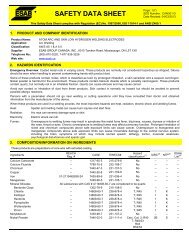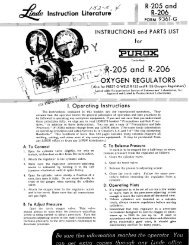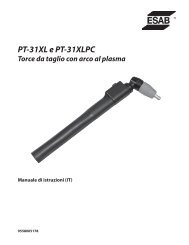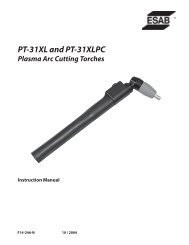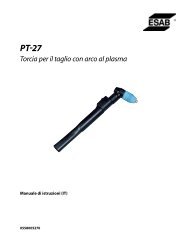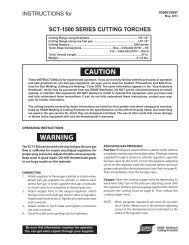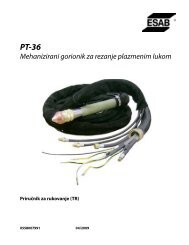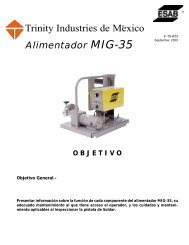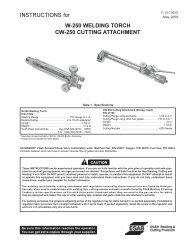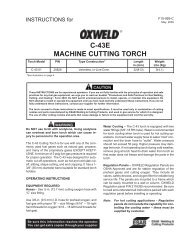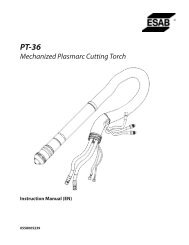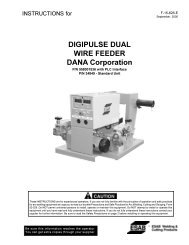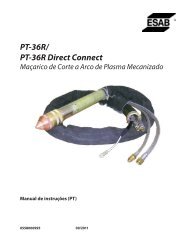You also want an ePaper? Increase the reach of your titles
YUMPU automatically turns print PDFs into web optimized ePapers that Google loves.
SAFETY PRECAUTIONSThese Safety Precautions are for your protection. They summarizeprecautionary information from the references listedin Additional Safety Information section. Before performing anyinstallation or operating procedures, be sure to read and followthe safety precautions listed below as well as all othermanuals, material safety data sheets, labels, etc. Failure to observeSafety Precautions can result in injury or death.PROTECT YOURSELF AND OTHERS - Somewelding, cutting and gouging processes arenoisy and require ear protection. Hot metal cancause skin burns and heat rays may injureeyes. Training in the proper use of the processesand equipment is essential to preventaccidents. Also:1. Always wear safety glasses with side shields in any work area,even if welding helmets, face shields, or goggles are also required.2. Wear flameproof gauntlet type gloves, heavy long-sleeve shirt,cuffless trousers, high-topped shoes, and a welding helmet orcap for hair protection, to protect against hot sparks and hotmetal. A flameproof apron may also be desirable as protectionagainst radiated heat and sparks.3. Hot sparks or metal can lodge in rolled up sleeves, trouserscuffs, or pockets. Sleeves and collars should be kept buttoned,and open pockets eliminated from the front of clothing.4. Protect other personnel from hot sparks with a suitable nonflammablepartition or curtains.5. Use goggles over safety glasses when chipping slag or grinding.Chipped slag may be hot and can travel considerable distances.Bystanders should also wear goggles over safetyglasses.FIRES AND EXPLOSIONS - Heat from a flamecan act as an ignition source. Hot slag or sparkscan also cause fires or explosions. Therefore:1. Remove all combustible materials well away from the workarea or completely cover the materials with a protective nonflammablecovering. Combustible materials include wood,cloth, sawdust, liquid and gas fuels, solvents, paints and coatings,paper, etc.2. Hot sparks or hot metal can fall through cracks or crevices infloors or wall openings and cause a hidden smoldering fire onthe floor below. Make certain that such openings are protectedfrom hot sparks and metal.3. Do not weld, cut, or perform any other hot work on materials,containers, or piping until it has been completely cleaned sothat no substances on the material can produce flammable ortoxic vapors. Do not do hot work on closed containers. Theymay explode.4. Have fire extinguishing equipment handy for instant use, suchas a garden hose, a pail of water or sand, or portable fireextinguisher. Be sure you are trained in its use.5. After completing operations, inspect the work area to be surethat there are no hot sparks or hot metal which could cause alater fire. Use fire watchers when necessary.6. For additional information, refer to NFPA Standard 51B, “FirePrevention in Use of Cutting and Welding Processes”, whichis available from the National Fire Protection Association,Batterymarch Park, Quincy, MA 02269.FUMES AND GASES - Fumes and gases, particularlyin confined spaces, can cause discomfortor injury. Do not breathe fumes orgases from welding or cutting, Therefore:1. Always provide adequate ventilation in the work area by naturalor mechanical ventilation means. Do not weld, cut, or gougeon materials such as galvanized steel, stainless steel, copper,zinc, lead, beryllium, or cadmium unless positive mechanicalventilation is provided. Do not breathe fumes and gases fromthese materials.2. If you develop momentary eye, nose, or throat irritation whileoperating, this is an indication that ventilation is not adequate.Stop work at once and take necessary steps to improve ventilationin the work area. Do not continue to operate if physicaldiscomfort persists.23. Refer to ANSI/ASC Standard Z49.1 listed below for specificventilation recommendations.EQUIPMENT MAINTENANCE - Faulty or improperlymaintained equipment, such as torches, hoses andregulators, can result in poor work, but even moreimportant, it can cause injury or death through fires.Therefore:1. Always have qualified personnel perform the installation,troubleshooting, and maintenance work. Do not operate orrepair any equipment unless you are qualified to do so.2. Keep all oxy-fuel equipment free of grease or oil. Grease, oil,and other similar combustible materials, when ignited, can burnviolently in the presence of oxygen.3. Do not abuse any equipment or accessories. Keep equipmentaway from heat and wet conditions, oil or grease, corrosiveatmospheres and inclement weather.4. Keep all safety devices in position and in good repair.5. Use equipment for its intended purpose. Do not modify it inany manner.GAS CYLINDER HANDLING - Gas cylinders, ifmishandled, can rupture or explode violently.Sudden rupture of a cylinder, valve or relief devicecan injure or kill you. Therefore:1. Use the proper gas for the process and use the proper pressurereducing regulator designed to operate from the compressedgas cylinder. Do not use adaptors to mount the regulatoron the cylinder. Maintain hoses and fittings in good condition.Follow manufacturer’s operating instructions for mountingthe regulator to the gas cylinder.2. Always secure cylinders in an upright position by chain or strapto suitable hand trucks, benches, walls, post, or racks. Neversecure cylinders to work tables or fixtures where they maybecome part of an electrical circuit.3. When not in use, keep cylinder valves closed. Have the valveprotection cap in place on top of the cylinder if no regulators isinstalled. Secure and move cylinders by using suitable handtrucks. Avoid rough handling of cylinders.4. Locate cylinders away from heat, sparks, or flame of a welding,cutting, or gouging operation. Never strike an arc on acylinder.5. For additional information, refer to CGA Standard P-1, “Precautionsfor Safe Handling of Compressed Gases in Cylinders:,which is available from the Compressed Gas Association,1235 Jefferson Davis Highway, Arlington, VA 22202.ADDITIONAL SAFETY INFORMATION - For more informationon safe practices for oxy-fuel welding andcutting equipment, ask your distributor for a copy of“Precautions and Safe Practices for Gas Welding, Cutting,and Heating”, Form 2035. Gas apparatus safetyguidelines are also available on video cassettes fromyour distributor.The following publications, which are available from the AmericanWelding Society, 550 N.W. LeJuene Road, Miami, FL 33126, arerecommended to you:1. ANSI/AWS Z49.1 - “Safety in Welding and Cutting”.2. AWS F4.1 - “Recommended Safe Practices for the Preparationfor Welding and Cutting of Containers and Piping ThatHave Held Hazardous Substances”/3. AWS SP - “Safe Practices” - Reprint, Welding Handbook.This symbol appearing in this manual meansAttention! Be Alert! Your safety is involved.Used to call attention to immediate hazardswhich, if not avoided, will result in immediate,serious personal injury or loss of life.Used to call attention to potential hazardswhich could result in personal injury or loss oflife.Used to call attention to hazards which couldresult in minor personal injury.SP-GA 7/97



